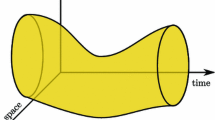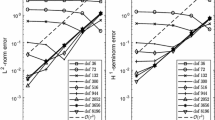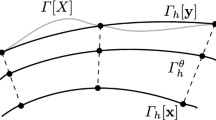Abstract
We propose a simple and efficient direct discretization scheme for solving the Cahn–Hilliard (CH) equation on an evolving surface. By using a conservation law and transport formulae, we derive the CH equation on evolving surfaces. An evolving surface is discretized using an unstructured triangular mesh. The discrete CH equation is defined on the surface mesh and its dual surface polygonal tessellation. The evolving triangular surfaces are then realized by moving the surface nodes according to a given velocity field. The proposed scheme is based on the Crank–Nicolson scheme and a linearly stabilized splitting scheme. The scheme is second-order accurate, with respect to both space and time. The resulting system of discrete equations is easy to implement, and is solved by using an efficient biconjugate gradient stabilized method. Several numerical experiments are presented to demonstrate the performance and effectiveness of the proposed numerical scheme.









Similar content being viewed by others
References
Cahn, J.W., Hilliard, J.E.: Free energy of a non-uniform system I. Interfacial free energy. J. Chem. Phys. 28, 258–267 (1958)
Armstrong, N.J., Painter, K.J., Sherratt, J.A.: A continuum approach to modelling cell–cell adhesion. J. Theor. Biol. 243, 98–113 (2006)
Wise, S., Lowengrub, J., Frieboes, H., Cristini, V.: Three-dimensional multispecies nonlinear tumor growth: I. model and numerical method. J. Theor. Biol. 253, 524–543 (2008)
Kim, J.: Phase-field models for multi-component fluid flows. Commun. Comput. Phys. 12, 613–661 (2012)
Li, Y., Choi, J.-I., Kim, J.: A phase-field fluid modeling and computation with interfacial profile correction term. Commun. Nonlinear Sci. Numer. Simul. 30, 84–100 (2016)
Li, Y., Shin, J., Choi, Y., Kim, J.S.: Three-dimensional volume reconstruction from slice data using phase-field models. Comput. Vis. Image Und. 137, 115–124 (2015)
Archer, A.J., Evans, R.: Dynamical density functional theory and its application to spinodal decomposition. J. Chem. Phys. 121, 4246–4254 (2004)
Marconi, U.M.B., Tarazona, P.: Dynamic density functional theory of fluids. J. Chem. Phys. 110, 8032–8044 (1999)
Yang, S.-D., Lee, H.G., Kim, J.S.: A phase-field approach for minimizing the area of triply periodic surfaces with volume constraint. Comput. Phys. Commun. 181, 1037–1046 (2010)
Erlebacher, J., Aziz, M.J., Karma, A., Dimitrov, N., Sieradzki, K.: Evolution of nanoporosity in dealloying. Nature 410, 450–453 (2001)
Baumgart, T., Hess, S., Webb, W.: Imaging coexisting fluid domains in biomembrane models coupling curvature and line tension. Nature 425, 821–824 (2003)
Tang, P., Qiu, F., Zhang, H., Yang, Y.: Phase separation patterns for diblock copolymers on spherical surfaces: a finite volume method. Phys. Rev. E 72, 016710 (2005)
Jeong, D., Kim, J.K.: Microphase separation patterns in diblock copolymers on curved surfaces using a nonlocal Cahn-Hilliard equation. Eur. Phys. J. E 38, 1–7 (2015)
Bausch, A., et al.: Grain boundary scars and spherical crystallography. Science 299, 1716–1718 (2003)
Lee, H.-G., Kim, J.: A simple and efficient finite difference method for the phase-field crystal equation on curved surfaces. Comput. Methods Appl. Mech. Eng. 307, 32–43 (2016)
Mercker, M., Ptashnyk, M., Kuhnle, J., Hartmann, D., Weiss, M., Jager, W.: A multiscale approach to curvature modulated sorting in biological membranes. J. Theor. Biol. 301, 67–82 (2012)
He, Y., Liu, Y., Tang, T.: On large time-stepping methods for the Cahn–Hilliard equation. Appl. Numer. Math. 57, 616–628 (2007)
Gomez, H., Hughes, T.J.R.: Provably unconditionally stable, second-order time-accurate, mixed variational methods for phase-field models. J. Comput. Phys. 230, 5310–5327 (2011)
Li, Y., Jeong, D., Shin, J., Kim, J.S.: A conservative numerical method for the Cahn–Hilliard equation with Dirichlet boundary conditions in complex domains. Comput. Math. Appl. 65, 102–115 (2013)
Li, Y., Lee, H.G., Xia, B., Kim, J.: A compact fourth-order finite difference scheme for the three-dimensional Cahn–Hilliard equation. Comput. Phys. Commun. 200, 108–116 (2016)
Song, H., Shu, C.-W.: Unconditional energy stability analysis of a second order implicit-explicit local discontinuous galerkin method for the Cahn–Hilliard equation. 1–26 (2017)
Du, Q., Ju, L., Tian, L.: Finite element approximation of the Cahn–Hilliard equation on surfaces. Comput. Methods Appl. Mech. Eng. 200, 2458–2470 (2011)
Elliott, C.M., Ranner, T.: Evolving surface finite element method for the Cahn–Hilliard equation. Numer. Math. 129, 483–534 (2015)
Rätz, A., Voigt, A.: PDE’s on surfaces—A diffuse interface approach. Commun. Math. Sci. 4, 575–590 (2006)
Witkowski, T., Backofena, R., Voigt, A.: The influence of membrane bound proteins on phase separation and coarsening in cell membranes. Phys. Chem. Chem. Phys. 14, 14509–14515 (2012)
Bertalmio, M., Cheng, L.-T., Osher, S., Sapiro, G.: Variational problems and partial differential equations on implicit surfaces. J. Comput. Phys. 174, 759–780 (2001)
Xu, J.-J., Zhao, H.-K.: An Eulerian formulation for solving partial differential equations along a moving interface. J. Sci. Comput. 19, 1–3 (2003)
Adalsteinsson, D., Sethian, J.A.: Transport and diffusion of material quantities on propagating interfaces via level set methods. J. Comput. Phys. 185, 271–288 (2003)
Greer, J., Bertozzi, A.L., Saporo, G.: Fourth order partial differential equations on general geometries. J. Comput. Phys. 216, 216–246 (2006)
Dziuk, G., Elliott, C.M.: An Eulerian approach to transport and diffusion on evolving implicit surfaces. Comput. Vis. Sci. 13, 17–28 (2010)
Leung, S., Lowengrub, J., Zhao, H.K.: A grid based particle method for solving partial differential equations on evolving surfaces and modeling high order geometrical motion. J. Comput. Phys. 230, 2540–2561 (2011)
Rong, G., Jin, M., Shuai, L., Guo, X.: Centroidal Voronoi tessellation in universal covering space of manifold surfaces. Comp. Aided Geom. Des. 28, 475–496 (2011)
Sun, F., Choi, Y.-K., Wang, W., Yan, D.-M., Liu, Y., Lévy, B.: Obtuse triangle suppression in anisotropic meshes. Comp. Aided Geom. Des. 28, 537–548 (2011)
Dziuk, G., Elliott, C.M.: Finite elements on evolving surfaces. IMA J. Numer. Anal. 27, 262–292 (2007)
Willmore, T.J.: Riemannian Geometry. Clarendon Press, New York (1993)
Chen, S.-G., Wu, J.-Y.: Estimating normal vectors and curvatures by centroid weights. Comp. Aided Geom. Des. 21, 447–458 (2004)
Chen, S.-G., Wu, J.: Discrete conservation laws on evolving surfaces. SIAM J. Sci. Comput. 38, A1725–A1742 (2016)
Chen, S.-G., Wu, J.: Discrete conservation laws on curved surfaces. SIAM J. Sci. Comput. 36, 719–39 (2013)
Li, Y., Wang, N., Kim, J.: An unconditionally energy-stable second-order time-accurate scheme for the Cahn-Hilliard equation on surfaces. Commun. Nonlinear. Sci. Numer. Simul. 53, 213–227 (2017)
van der Vorst, H.A.: BI-CGSTAB: a fast and smoothly converging variant of BI-CG for the solution of nonsymmetriclinear systems. SIAM J. Sci. Stat. Comput. 13(2), 631–644 (1992)
Hua, H., Li, Y., Shin, J., Song, H., Kim, J.: Effect of confinement on droplet deformation in shear flow. Int. J. Comput. Fluid D. 27, 317–331 (2013)
Li, Y., Kim, J.: Three-dimensional simulations of the cell growth and cytokinesis using the immersed boundary method. Math. Biosci. 271, 118–127 (2016)
Li, Y., Kim, J.: Multiphase image segmentation using a phase-field model. Comput. Math. Appl. 62, 737–745 (2011)
Li, Y., Jeong, D., Choi, J.-I., Lee, S., Kim, J.: Fast local image inpainting based on the Allen–Cahn model. Digit. Signal Process. 37, 65–74 (2015)
Li, Y., Kim, J.: Fast and efficient narrow volume reconstruction from scattered data. Pattern Recognit. 48, 4057–4069 (2015)
Li, Y., Yun, A., Kim, J.: An immersed boundary method for simulating a single axisymmetric cell growth and division. J. Math. Biol. 65, 653–675 (2012)
Acknowledgements
Y.B. Li is supported by National Natural Science Foundation of China(Nos. 11601416, 11631012). The corresponding author (J.S. Kim) was supported by Basic Science Research Program through the National Research Foundation of Korea (NRF) funded by the Ministry of Education (NRF-2016R1D1A1B03933243). The authors thank the reviewers for the constructive and helpful comments concerning the revision of this article.
Author information
Authors and Affiliations
Corresponding author
Rights and permissions
About this article
Cite this article
Li, Y., Qi, X. & Kim, J. Direct Discretization Method for the Cahn–Hilliard Equation on an Evolving Surface. J Sci Comput 77, 1147–1163 (2018). https://doi.org/10.1007/s10915-018-0742-6
Received:
Revised:
Accepted:
Published:
Issue Date:
DOI: https://doi.org/10.1007/s10915-018-0742-6




